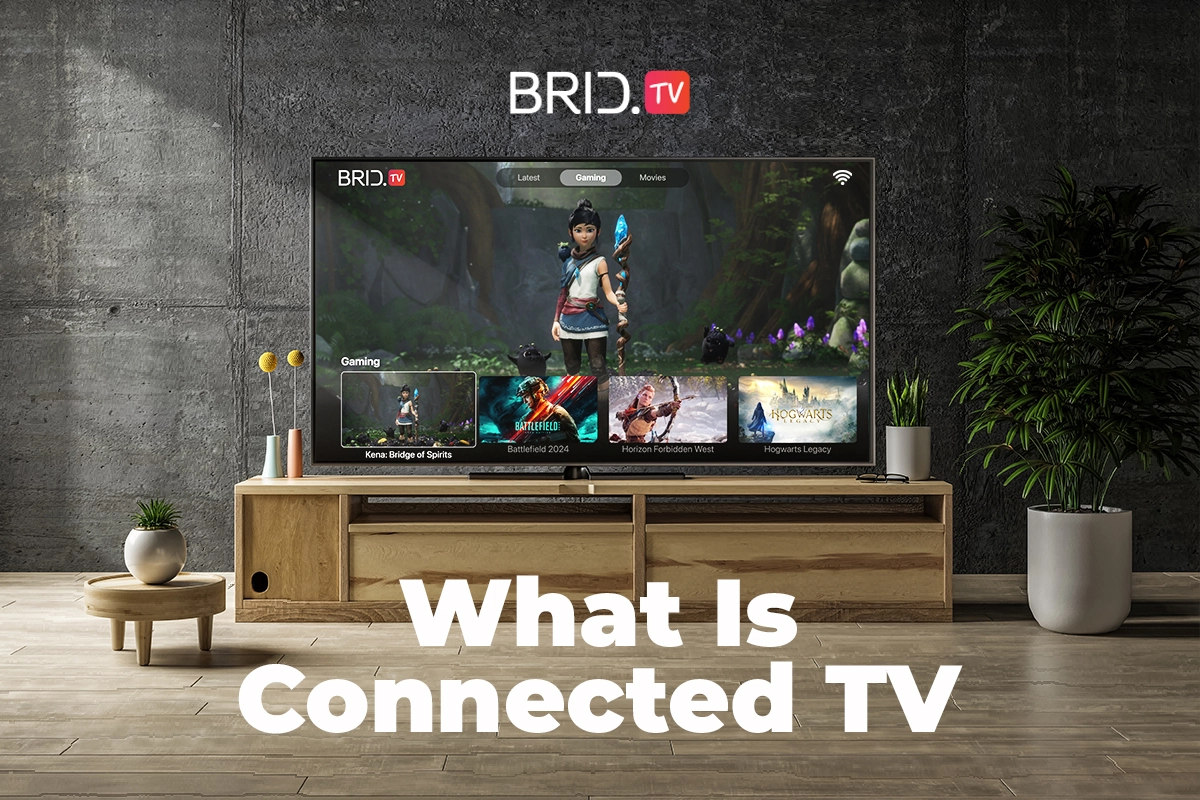With the popularity of video content continuously growing, publishers and broadcasters are constantly looking for new ways to reach audiences worldwide. One such way is connected TV (CTV). But what is connected TV exactly and is it worth investing in?
If you ask us, CTV is here to stay. It is a great way for broadcasters to reach cord-cutting viewers and keep up with the latest trends. So without further ado, let’s dig deeper into what CTV is exactly, how it works, and how to launch your own CTV app.
- What Is Connected TV (CTV)?
- How Does CTV Work?
- What Is the Difference Between CTV and OTT?
- What Is the Difference Between CTV and Linear TV?
- Why Is CTV an Important Distribution Channel for Publishers?
- Benefits of Connected TV for Publishers
- How Can Publishers Get Their Content on CTV?
- Launch a CTV App With TargetVideo
- FAQ
What Is Connected TV (CTV)?
Connected TV, or CTV for short, is any television device that is connected to the internet. The main purpose of CTV is to enable viewers to stream video content from the internet straight to the big screen. This simulates the experience of watching traditional cable TV with the added convenience of access to on-demand content.
Types of CTV Devices
Smart TVs have CTV capabilities by default. Their operating systems allow them to connect to the internet, download applications, and stream all kinds of content. However, even a non-smart television set can be turned into a connected TV. To do this, we would need a CTV device. There are several different types of these devices:
- TV Boxes — Boxes such as Apple TV and Chromecast serve as a connection point between a non-smart television set and the internet. They allow users to stream on-demand content and download apps on their TV, which they otherwise wouldn’t have been able to do.
- TV Sticks — Streaming sticks work more or less in the same way as boxes. The only difference is that they are usually smaller. Some of the most popular sticks are Amazon Fire Stick, Roku Streaming Stick, and Mi TV Stick.
- Gaming Consoles — Although video games are their main purpose, gaming consoles also double as connected devices with the same functionalities as boxes and sticks.
If you have heard the term OTT devices before, this might be a little confusing. In short, OTT devices refer to any device that can stream OTT content, and CTV devices are a part of that.

How Does CTV Work?
As we have already mentioned, CTV requires an internet connection to work. A CTV device, be it a smart TV, stick, or console, allows the user to access their streaming app of choice, such as Netflix, via the internet.
From this point, the process is similar to accessing streaming services through a PC. A user picks a piece of content they want to watch. The video host’s server then sends an encoded video file to a video player using a content delivery network. The player then decodes the video and plays it.
What Is the Difference Between CTV and OTT?
The terms CTV and OTT are often used interchangeably. However, although they are related, they denote different things. CTV, as we have seen, refers to the hardware necessary to stream content online. OTT, on the other hand, is a content delivery method that uses the internet and bypasses cable and satellite. Put simply, we can use CTV to access OTT streaming services and their content.
What Is the Difference Between CTV and Linear TV?
Much like OTT, linear TV has little to do with the actual hardware used to access it. The term linear TV refers to programmed content delivery that follows a specific schedule. The most common use of linear TV is traditional television programming, although there are online streaming services that use this form of content delivery, too. In short, linear TV is the exact opposite of VOD, where viewers can watch what they want and when they want.
Why Is CTV an Important Distribution Channel for Publishers?
Publishers looking to scale their business and expand their viewer base should definitely consider including CTV apps in their offer. According to statistics, two-thirds of streaming service subscribers use connected TV to access their favorite content. In the US alone, estimates show that almost 200 million people use connected TV.
Needless to say, with a video monetization method set in place, this huge audience translates to more revenue, too. On average, when publishers include a CTV app in their offer, their revenue increases by a third!

Benefits of Connected TV for Publishers
As you can tell, publishers can gain a lot from offering content through connected TV. With more and more cord-cutting households across the globe, broadcasters need to turn to the internet to deliver content. With CTV, you can tap into a group of viewers who otherwise might have never come across your streaming service.
The main benefit that comes with a wider audience is, of course, a higher earning potential. Whether you decide to have viewers subscribe to your streaming service, pay for individual pieces of content, or access it for free and watch ads, CTV can certainly bring in more revenue.
Speaking of ads, CTV advertising is much more affordable than some other traditional advertising channels, such as linear television, making it attractive to advertisers. It is also easier to target the right audience and track the performance of ads in real time than with linear TV advertising.
Lastly, CTV supports both programmatic advertising and contextual ad targeting. In other words, if you decide to monetize your CTV content through AVOD, you shouldn’t have any issues generating revenue.
How Can Publishers Get Their Content on CTV?
Are you interested in getting your content on connected TV? Then all you need to do is add a CTV-compatible app to your portfolio. If you have the know-how, you can do this entirely yourself. If you’re not a developer, it would be easier to hire one. However, hiring a professional to build an app from scratch costs tens of thousands of dollars, and if you’re just starting out, that might be more than you’re willing to spend.
The easiest and most cost-effective way to launch your CTV app is using a white-label app builder. While these builders don’t give you total control over the appearance of your app, there are still extensive customization and branding options. Not to mention, with the right builder, your app will be ready to launch within days, as opposed to the several months that it would take a developer to build it.
Once you have the app, you will also need a way to monetize your content. If you decided to go with ad-based monetization, you will need a reliable CTV advertising platform and video ad network by your side. With the right platform, selling ad inventory and serving all kinds of video ad formats will be a piece of cake.
Launch a CTV App With TargetVideo
Looking for a way to build your CTV streaming app? TargetVideo helps broadcasters, publishers, and content creators deliver their videos to audiences worldwide on a wide variety of devices, CTV included. With TargetVideo’s white-label, CTV and OTT apps, you can rest assured your viewers will get the ultimate experience while you collect your video ad revenue.
FAQ
1. What does CTV stand for?
CTV stands for connected TV. The term refers to any television set, such as smart TVs, which can connect to the internet.
2. What’s the difference between OTT and CTV?
The difference between OTT and CTV is that OTT is a content delivery method, while CTV refers to devices. CTV devices can be used to stream OTT content.
3. What’s the difference between CTV and linear TV?
The difference between linear TV and CTV is that linear TV is a content delivery method that imitates traditional television scheduling, and CTV is any television set that connects to the internet. In other words, CTV refers to hardware, while linear TV is a content programming method.
4. What are the biggest CTV companies?
The biggest CTV broadcasters are Hulu, Sling TV, and Netflix. If you want to launch your own CTV streaming service, reach out to TargetVideo to learn how.
